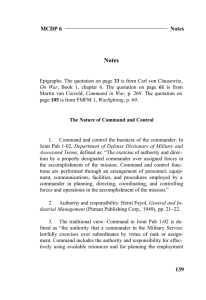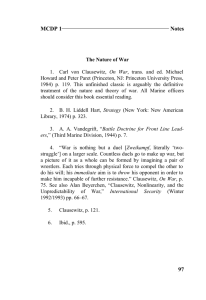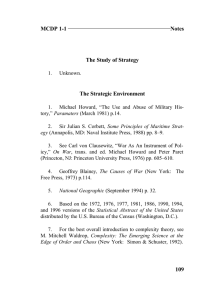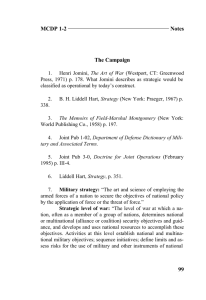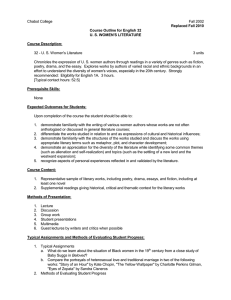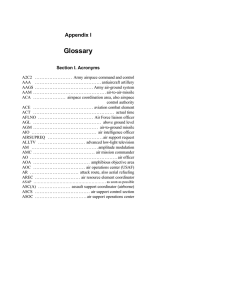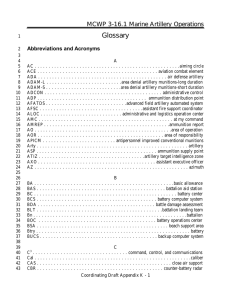MCDP 5 Notes
advertisement
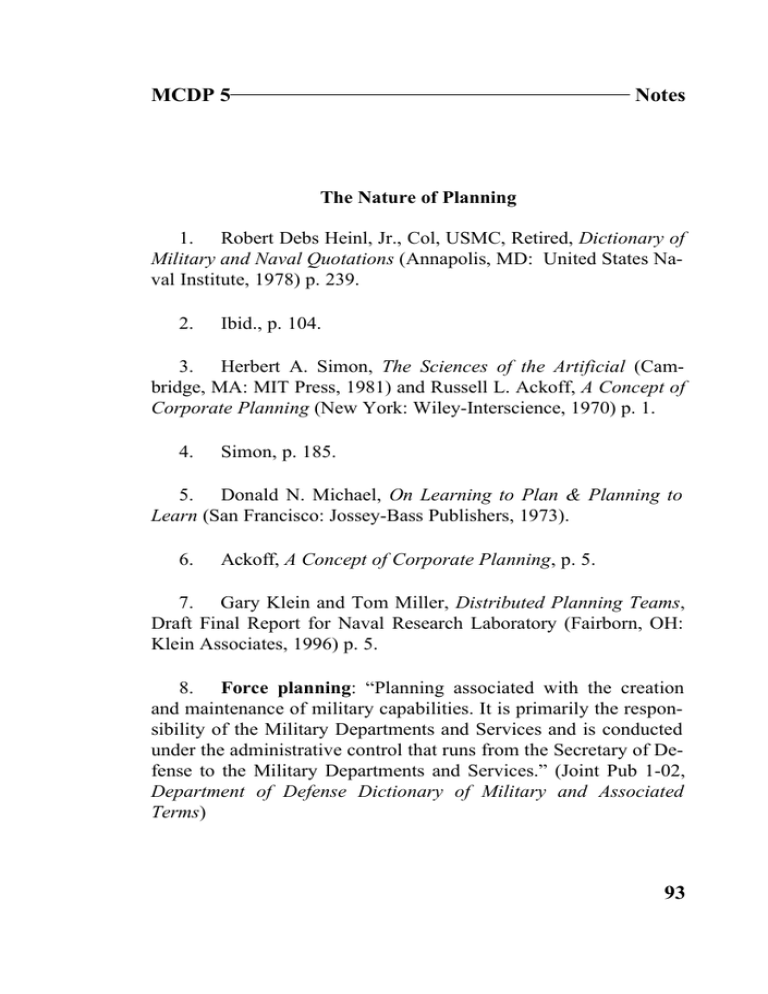
MCDP 5 Notes The Nature of Planning 1. Robert Debs Heinl, Jr., Col, USMC, Retired, Dictionary of Military and Naval Quotations (Annapolis, MD: United States Naval Institute, 1978) p. 239. 2. Ibid., p. 104. 3. Herbert A. Simon, The Sciences of the Artificial (Cambridge, MA: MIT Press, 1981) and Russell L. Ackoff, A Concept of Corporate Planning (New York: Wiley-Interscience, 1970) p. 1. 4. Simon, p. 185. 5. Donald N. Michael, On Learning to Plan & Planning to Learn (San Francisco: Jossey-Bass Publishers, 1973). 6. Ackoff, A Concept of Corporate Planning, p. 5. 7. Gary Klein and Tom Miller, Distributed Planning Teams, Draft Final Report for Naval Research Laboratory (Fairborn, OH: Klein Associates, 1996) p. 5. 8. Force planning: “Planning associated with the creation and maintenance of military capabilities. It is primarily the responsibility of the Military Departments and Services and is conducted under the administrative control that runs from the Secretary of Defense to the Military Departments and Services.” (Joint Pub 1-02, Department of Defense Dictionary of Military and Associated Terms) 93 Planning MCDP 5 9. Operation annexes: “Those amplifying instructions which are of such a nature, or are so voluminous or technical, as to make their inclusion in the body of the plan or order undesirable.” (Joint Pub 1-02) 10. As used throughout this publication, the term “planner” refers to any person, including commanders, involved in planning and not only to members of a designated planning staff. 11. Lloyd R. Amey, Corporate Planning: A Systems View (New York: Praeger, 1986) p. 18. 12. MCDP 6, Command and Control (October 1996) p. 46. 13. Klein and Miller, pp. 5–6. See also Henry Mintzberg, The Rise and Fall of Strategic Planning: Reconceiving Roles for Planning, Plans, Planners (New York: The Free Press, 1994) pp. 333–361. 14. The types of plans are defined in Joint Pub 1-02 and described in Joint Pub 5-0, Doctrine for Planning Joint Operations, chapter 1, section 13 (April 1995). 15. Directive: “1. A military communication in which policy is established or a specific action is ordered. 2. A plan issued with a view to putting it into effect when so directed, or in the event that a stated contingency arises. 3. Broadly speaking, any communication which initiates or governs action, conduct, or procedure.” (Joint Pub 1-02) 94 MCDP 5 Notes 16. Carl von Clausewitz, On War, trans. by Michael Howard and Peter Paret (Princeton, NJ: Princeton University Press, 1984) p. 199. 17. Ackoff, A Concept of Corporate Planning, p. 1. 18. Mintzberg, chapters 4 and 5. 19. For example, see Richard E. Hayes, Symposium of C2 Research and Decision Aids, for the Naval Post Graduate School Technology Panel for C3, Joint Directors for Laboratories, and National Defense University (Vienna, VA: Evidence Based Research, Inc. 1994). This study of the U.S. Army showed that division and brigade plans lasted only about 65 percent as long as they were intended to last and that only about 58 percent of the elements of a plan survived for the intended duration of the plan. 20. Hasan Ozbekhan, “Toward a General Theory of Planning” Prospectives of Planning, ed., Erich Jantsch (Paris: Organisation for Economic Co-operation and Development, 1969) p. 114. Planning Theory 1. Gen George S. Patton, Jr., War as I Knew It (Boston: Houghton Mifflin Company, 1947) p. 354. 2. Battle Doctrine for Front Line Leaders (Quantico, Va: Marine Corps Development and Education Command, Education 95 Planning MCDP 5 Center, 1981) p. 1. This publication was originally written and published as a training guide by the 3d Marine Division, Fleet Marine Force, under the command of Gen A. A. Vandegrift during World War II. 3. Our use of the term “planning process” provides a conceptual model for those activities which occur during the formulation of a plan. This model is not intended to replace other formal, prescribed methodologies such as the Joint Operation Planning and Execution System (JOPES) process or the rapid response planning process used by Marine expeditionary unit (special operations capable) staffs. 4. Ackoff, A Concept of Corporate Planning, p. 24. 5. Gary Klein, John Schmitt, Mike McCloskey, Jennifer Heaton, Dave Klinger, and Steve Wolf, A Decision-Centered Study of the Regimental Command Post (Fairborn, OH: Klein Associates, 1996). “With regard to critiquing a plan, we rarely saw this occur as a separate step in the planning cycle. We expected that once a plan was completed it would be subjected to a critical review. Instead, in the planning sessions we observed, the critiquing was embedded within the planning process. . . . “For purposes of efficiency, it makes good sense to do the critiquing during the plan development. If someone has a concern, better to voice it at the time rather than wait until afterwards (particularly in a setting where interruptions are frequent). Furthermore, once a plan is completed it is difficult for the planning team to turn around and raise serious criticisms. If there is a need to critique a plan after it is developed, perhaps the most effective strategy is to bring in an experienced officer who was not part of the planning team, as an outside perspective.” p. 30. 96 MCDP 5 Notes 6. John R. Boyd, “Destruction and Creation,” unpublished paper, 3 September 1976. See also Mintzberg, pp. 298–321 and 324–333; Gary A. Klein, “Strategies of Decision Making,” Military Review (May 1989) pp. 56–64; and Maj John F. Schmitt, “How We Decide,” Marine Corps Gazette (October 1995) pp. 16–20. 7. Our use of “functional planning” should not be confused with the definition of a “functional plan” provided in Joint Pubs 5-0 and 1-02. We are not describing a specific type of plan but rather a conceptual level within the planning hierarchy. In addition, the present definition in Joint Pub 1-02 defines functional plans as involving “the conduct of military operations in a peacetime or permissive environment,” which limits functional plans to noncombat operations. In contrast, our discussion of functional planning applies across the spectrum of conflict. An updated definition of functional plans is being developed for the next edition of Joint Pub 1-02 which will expand the usage of functional plans within other operating environments (combat as well as peacetime or permissive). 8. Ackoff, A Concept of Corporate Planning, pp. 16–17. 9. Execution planning: “The phase of the Joint Operation Planning and Execution System crisis action planning process that provides for the translation of an approved course of action into an executable plan of action through the preparation of a complete operation plan or operation order. Execution planning is detailed planning for the commitment of specified forces and resources. During crisis action planning, an approved operation plan or other National Command Authorities-approved course of action is adjusted, refined, and translated into an operation order. Execution planning can proceed on the basis of deliberate planning, or it can take place in the absence of prior planning.” (Joint Pub 1-02) 97 Planning MCDP 5 10. As used here, the terms “deliberate and rapid planning” refer broadly to planning considerations based on available time and not to any specific phase of the Joint Operation Planning and Execution System. Deliberate planning: “A planning process for the deployment and employment of apportioned forces and resources that occurs in response to a hypothetical situation. Deliberate planners rely heavily on assumptions regarding the circumstances that will exist when the plan is executed.” (Joint Pub 1-02) Rapid planning: “The time-sensitive planning for the deployment, employment, and sustainment of assigned and allocated forces and resources that occurs in response to a situation that may result in actual military operations.” (Joint Pub 1-02) (Also called crisis action planning.) 11. Dietrich Dörner, The Logic of Failure: Why Things Go Wrong and What We Can Do to Make Them Right, trans. by Rita and Robert Kimber (New York: Metropolitan Books, 1996) pp. 155–156. 12. Dörner, p. 155. 13. Ackoff, A Concept of Corporate Planning, p. 6; Klein and Miller, p. 7. 14. Dörner, p. 50. 15. Ibid., p. 70. 16. Leon Reinharth, H. Jack Shapiro, and Ernest A. Kallman, The Practice of Planning: Strategic, Administrative, and Operational (New York: Van Nostrand Reinhold Co., 1981) p. 18. 98 MCDP 5 Notes 17. Charles Perrow, Normal Accidents: Living with High-Risk Technologies (New York: Basic Books, 1984) especially chapter 3. 18. Klein and Miller, p. 9. 19. Ibid., p. 6. 20. General Sir Archibald Wavell, Allenby: A Study in Greatness; The Biography of Field-Marshal Viscount Allenby of Megiddo and Felixstowe, G.C.B., G.C.M.B. (New York: Oxford University Press, 1941) pp. 272–289. Planning Effectively 1. Heinl, p. 239. 2. Patton, p. 399. 3. Dörner, p. 161. 4. Klein and Miller, pp. 15–18. 5. Simon, p. 190. 6. Warning order: “A preliminary notice of an order or action which is to follow.” (Joint Pub 1-02) 7. Simon, p. 181. 8. Reinharth, Shapiro, and Kallman, p. 5. 99 Planning MCDP 5 9. Russell L. Ackoff, Redesigning the Future: A Systems Approach to Societal Problems (New York: John Wiley and Sons, 1974) p. 28. 10. Ackoff, Redesigning the Future: A Systems Approach to Societal Problems, p. 28. 11. Field Marshal Sir William Slim, Defeat Into Victory (London: Cassell and Co. Ltd., 1956) p. 211. 12. Ackoff, A Concept of Corporate Planning, p. 133. 13. Mintzberg, pp. 368–370. 14. Ibid., p. 364. 15. Ackoff, A Concept of Corporate Planning, p. 129. 100
